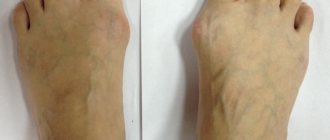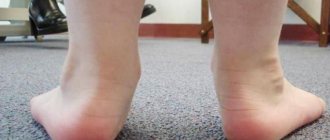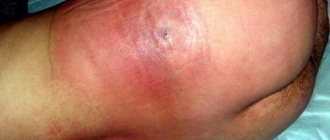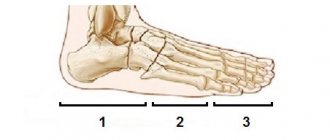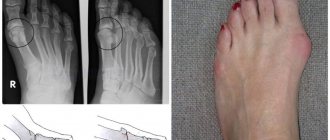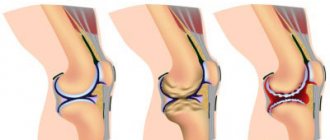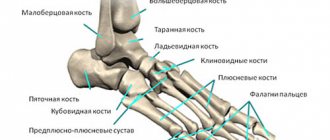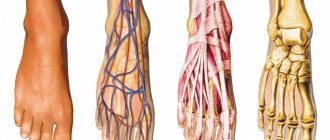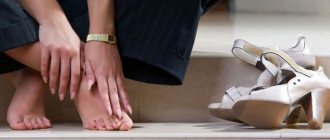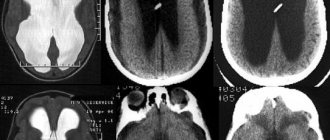Bumps on the toes are a manifestation of various diseases and complex deformities of the foot. Despite the common features of all these “bumps”—something begins to bulge on a finger or foot—the reasons for the appearance of “bumps” are completely different, and accordingly, their treatment is completely different.
Regardless of the etiology, all “bumps” cause a cosmetic defect, cause pain, and interfere with wearing shoes.
For some bunions, conservative treatment methods are sufficient and surgical treatment is not required. In others, surgical treatment methods are the only solution to the problem.
The effectiveness of treatment depends on the accuracy of diagnosis and the choice of the correct treatment method. Incorrect diagnosis and treatment methods can only guarantee the loss of your time and money, and sometimes your health.
Familiarize yourself with the different types of lumps and some of the diseases that can cause them to form.
Lumps in the area of the first metatarsophalangeal joint, formed by osteophytes.
Hallux valgus
| A. Appearance of the foot | b. corns on the sole of the foot | |
This is the most common cause of a lump. It is accompanied by drooping of the arches of the feet. A bunion with hallux valgus has the following features:
- hard, immobile, increases in size slowly;
- a rapid increase in the size of the bone is associated with the development of bursitis;
- located at the base of the first finger;
- the first finger is deviated outward;
- Calluses (corns) may form on the sole of the foot;
- Deformation of the 2nd finger is often observed.
Arthrosis of the first metatarsophalangeal joint
Bone growths form along the perimeter of the articular surfaces of the first metatarsal bone and the base of the proximal phalanx of the first finger.
- the “bone” is formed mostly in the area of the head of the first metatarsal bone on the back of the foot, but osteophytes can be along the entire perimeter of the joint;
- The first metatarsophalangeal joint is mainly deformed in isolation.
- first of all, movements in the joint are limited, and in the future they may be completely absent;
- patients feel severe pain, which becomes constant over time.
| A. side view of the foot | b. top view of the foot |
| V. x-ray of the foot | d. joint changes |
| “Lump” with arthrosis of the metatarsophalangeal joint | |
Preparing for bunion surgery
At the initial consultation, the doctor will explain the surgical plan to you and tell you how to prepare your leg for surgery.
If the diseased bone on the foot is not too large, and there are no changes in other toes that require intervention, the entire hospitalization will take only one day.
It is a good idea to prepare your home for the recovery period following surgery. You may want to rearrange your furniture to make it easier to walk around. It is also advisable to stock up on food so that you don’t have to go shopping, which will be uncomfortable given the pain in your finger.
Surgery to remove the bunion to relieve pain in the big toe can be performed under either local or general anesthesia. If the operation is performed under local anesthesia, after several injections at the level of the ankle joint, you will no longer feel your feet. The operation can also be performed under spinal anesthesia, in which sensitivity will be completely absent in both lower extremities, which means the patient will not feel pain.
Before any of these anesthetics, it is recommended that you do not eat for 6 hours before your planned surgery.
Your surgeon will tell you what will happen before, during, and after surgery. If there is something you don't understand, don't hesitate to ask. After you ask all the questions you are interested in and receive answers to them, you will be allowed to sign a consent to undergo surgery on your leg.
Soft tissue lumps in the area of the first metatarsophalangeal joint
Characteristic features: soft, mobile, painful, warm to the touch, can quickly increase in size.
Bursitis of the mucous membrane of the metatarsophalangeal joint
Most often, this disease appears when there are bone growths in the area of the first metatarsophalangeal joint. Sometimes it can develop independently, for example, when, when wearing tight shoes, the mucous membrane is chronically injured and rubs against the shoes.
- a swelling appears on the inside of the foot at the base of the first toe;
- appears suddenly, quickly increases in size;
- there is redness of the skin in the area of the bump, it is often hot to the touch, painful, soft;
- sometimes the liquid in it is detected;
- Conservative treatment is effective and quickly gives good results.
| Bursitis in combination with hallux valgus and Taylor deformity, hammertoe deformity of the second finger |
Arthritis of the first metatarsophalangeal joint
In arthritis, a “bump” is formed due to inflamed soft tissues, swelling, and an increase in the amount of synovial fluid. The most common causes of arthritis are gout, infectious diseases (reactive arthritis), and systemic diseases (rheumatoid arthritis). Characteristic symptoms of a “bump” in arthritis:
- the skin at the base of the first finger is red, swelling is located along the entire perimeter of the joint, often very painful;
- it is soft, hot to the touch, and can be very painful;
- in some cases, general body temperature increases;
- conservative treatment methods are effective and quickly give positive results;
- The choice of treatment method depends on the causes of arthritis.
| Acute arthritis of the first metatarsophalangeal joint | ||
Bumps on 2-4 toes
Bunions on the 2nd to 4th toes are the result of hammertoes, claw toes, and mallet toes. Distinctive features:
- it is always formed by the head of the proximal or distal phalanx of the finger and bone growths. Sometimes the volume of the “bone” increases due to inflammation of the soft tissues;
- it is always located on the dorsum of the finger in the area of the proximal or distal interphalangeal joints;
| Hammertoe deformity, top and side view of the foot |
Causes
Many problems that arise in the legs are the result of abnormal pressure or friction. The easiest way to determine the presence of the consequences of pathological pressure is to examine the leg. The leg is a hard bone covered with skin. In most cases, symptoms develop gradually as the skin and soft tissues absorb the excess impact on the leg. Any protruding bone or injury aggravates the already existing consequences of the injury. The skin reacts to friction and pressure by forming a callus. The soft tissues located under the skin react to excess stress. Both the callus and the thickened soft tissue underneath the callus become painful and inflamed. Reducing pain helps to reduce pressure. Pressure can be reduced externally through looser shoes or internally through surgery and removal of excess tissue.
Taylor (tailor) deformation
Taylor deformity is characterized by varus deviation of the fifth toe and valgus deviation of the fifth metatarsal bone.
Characteristic signs of a “bump” on the foot:
- located at the base of the little finger;
- the fifth finger is deflected inwards, in some cases also upwards;
| “Bone” in Taylor deformity in combination with bursitis |
- The “bump” sharply increases in size and becomes painful when bursitis of the mucous bursa of the fifth metatarsophalangeal joint develops.
| “Bumps” and x-ray of the foot with Taylor deformity |
Arthrosis of the tarsal joints
Tarsal joints form between the bones of the midfoot. The midfoot constantly endures heavy loads during walking and running and is injured (microtrauma).
In this case, the articular surfaces are damaged, the cartilage becomes thinner, and over time osteophytes (bone growths) appear - arthrosis develops.
Characteristic symptoms:
- these “bones” are hard, often painful, and can increase in size due to inflammation of the soft tissues;
- they appear on the dorsal surface in the area of the instep of the foot;
- Walking in tight shoes can be very painful.
| A. Osteophytes in arthrosis of the metatarsocuneiform joint | A. Lump due to arthrosis of the metatarsocuneiform joint |
Hygroma of the foot
Hygroma is a “hernia” of the joint capsule or tendon sheath. A bulge can form on the dorsum of the foot from the ankle to the toes.
Features of hygroma on the foot:
- Forms on the dorsum of the foot. Hygromas on the plantar surface of the foot are rather an exception.
- At the beginning of its occurrence, it periodically appears and disappears, then becomes constant.
- Painless, dense or soft-elastic consistency, often mobile.
- When rubbing with shoes, signs of inflammation may appear: redness, pain, swelling.
- When wearing tight shoes it causes discomfort and pain.
| Appearance of the foot with hygromas |
Risk factors
- Shoes influence the incidence of hallux valgus (it is lower in adults who do not wear shoes). However, this does not mean that only shoes cause this disease. Tightening shoes can cause pain and pinching of the foot nerves along with the formation of hallux valgus. Fashionable shoes may be too tight and too narrow for the 'foot to look aesthetically pleasing.' High heels increase stress on the foot, further exacerbating the problem. Moreover, fashion trends are followed not only by young people, but also by people in the older age group. Risk factors can be divided into the main ones:
- There is a high probability of hallux valgus deformity in females. The cause may be shoes.
- Ballerinas who spend a lot of time on blocks dancing on their toes and thus may be expected to have a higher likelihood of developing hallux valgus
- Age. The incidence of deformity increases with age, with rates of 3% in people aged 15–30 years, 9% in people aged 31–60 years, and 16% in those over 60 years of age 1
- Genetic factors play a role
- Associated diseases
There are specific causes of biomechanical instability, including neuromuscular disorders. This may be associated with various types of arthritis. These associated diseases include:
- Gout.
- Rheumatoid arthritis.
- Psoriatic arthropathy.
- Joint hypermobility associated with diseases such as Marfan syndrome, Down syndrome.
- Multiple sclerosis.
- Sharot's disease
- Cerebral paralysis.
Gouty tophi
Gout is a disease associated with impaired purine metabolism. Tophi in gout are deposits of uric acid salts in tissues.
- Men are more likely to suffer from gout, and the main reason for visiting an orthopedist is tophi;
- The location of the tophi varies greatly: from the toes to the auricles.
- their size varies - from a few millimeters to gigantic sizes;
- tophi tumors are dense and painless;
- with chronic injury from shoes, they can become inflamed, infected and suppurate;
- when the tophi are opened, a white mass (urate crystals) is released from them;
- 15-20% of patients with gout are carriers of urate stones.
| Appearance of the foot with gouty tophi |
Treatment tactics:
- After conservative therapy and stabilization of uricemia levels, removal of tophi is indicated.
- It is preferable to perform operations for small sizes of tophi tumors, without waiting for their growth or purulent fistulous complications.
- The operations are local plastic in nature and are individual depending on the size and location of the tophi.
Are there alternatives to surgery for a sore big toe bone?
Not all people, when asked “what to do if the bones on the feet near the big toe hurt,” want to hear about the need for surgery. There are methods to relieve foot pain. True, if the problem is not solved, the foot disease will progress. Helps reduce pain and improve overall condition
- pain-relieving drugs
- silicone inserts for feet and toes,
- custom orthopedic insoles,
- night orthoses for fixing one or more fingers in the correct position,
- selection of comfortable shoes with the help of an orthopedist.
It should be remembered that in this case the deformity remains and the pain in the bone is relieved only temporarily.
